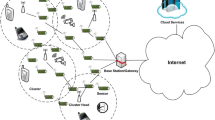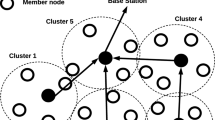Abstract
Wireless sensor network (WSN) is the predominantly used technology in building real-time event monitoring and dissemination frameworks for the internet of things (IoT) applications. However, WSN being power-hungry, fragile, and highly susceptible to loss of connectivity, it becomes vital to strengthen the network's communication reliability and energy efficiency. In this paper, a power-efficient compressive data fusion and cluster-based multi-hop relay-assisted protocol (PECDF-CMRP) for IoT sensor networks is proposed. Firstly, K-means algorithm is adapted to assign the nodes into unequal cells. Then cluster heads are nominated by multi-weight functions. Next, relays are chosen from the K cells to establish cooperative networks for data broadcast from the event sectors to the central gateway. The relay allocation is formulated as a maximization problem regarding the node's energy and path loss. The data aggregation is realized with single-level wavelet sparsity-based fusion. Experimental results confirm the supremacy of the proposed PECDF-CMRP in terms of reduced delay and energy consumption with enhanced lifetime and reception-ratio well above related models.



source CH







Similar content being viewed by others
Data availability
Not applicable.
Code availability
Available on request.
References
Elumalai, G., & Ramakrishnan, R. (2020). A novel approach to monitor and maintain database about physiological parameters of (Javelin) athletes using internet of things (IoT). Wireless Personal Communications, 111, 343–355. https://doi.org/10.1007/s11277-019-06862-5
Balasamy, K., Krishnaraj, N., Ramprasath, J., & Ramprakash, P. (2021). A secure framework for protecting clinical data in medical IoT environment. Smart Healthcare System Design: Security and Privacy Aspects. https://doi.org/10.1002/9781119792253.ch9
Suganyadevi, S., Shamia, D., & Balasamy, K. (2021). An IoT-based diet monitoring healthcare system for women. Smart Healthcare System Design: Security and Privacy Aspects. https://doi.org/10.1002/9781119792253.ch8
Jorge, M., Pardiñas, R., Lamberti, M. A., & Muller, & Gimenes C. (2018). Wireless sensor network as a living lab for the development of solutions for IoT and smart cities. ICETE: E-business and telecommunications. Portugal: Porto.
Agbulu G. P., Kumar G. J. R., and Kirubakaran D. (2022) A power-efficient and delay-sensitive mutipath sensor networks protocol for precision farming deployments. In Proc. International Conference on Advances in Computing, Communication and Applied Informatics (ACCAI), pp. 1–8. https://doi.org/10.1109/ACCAI53970.2022.9752508.
Mollah, M. B., Zeadally, S., & Azad, M. K. (2019). Emerging wireless technologies for internet of things applications: Opportunities and challenges. In X. Shen, X. Lin, & K. Zhang (Eds.), Encyclopedia of wireless networks. Cham: Springer.
Aranzazu-Suescun, C., & Cardei, M. (2019). Anchor-based routing protocol with dynamic clustering for Internet of Things WSNs. Journal on Wireless Communications and Networking. https://doi.org/10.1186/s13638-019-1447-8
Chowdhury, S. M., & Hossain, A. (2020). Different energy saving schemes in wireless sensor networks: A survey. Wireless Personal Communications, 114, 2043–2062.
Raja Basha, A. (2022). A review on wireless sensor networks: Routing. Wireless Personal Communications. https://doi.org/10.1007/s11277-022-09583-4
Joshitha, K. L., & Jayashri, S. (2019). Performance analysis for lifetime improvement of a regression based clustered network through cluster member allocation and secondary cluster head selection in a distributed WSN. Cluster Computing, 22, 9805–9814.
Wang, Q., Lin, D., Yang, P., & Zhang, Z. (2019). An energy-efficient compressive sensing-based clustering routing protocol for WSNs. IEEE Sensors Journal, 19(10), 3950–3960.
Zhang, J., Tang, J., Wang, T., & Chen, F. (2017). (2017) Energy-efficient data-gathering rendezvous algorithms with mobile sinks for wireless sensor networks. International Journal of Sensor Networks, 23(4), 248.
Tarhani, M., Kavian, Y. S., & Siavoshi, S. (2014). SEECH: Scalable energy efficient clustering hierarchy protocol in wireless sensor networks”. IEEE Sensors Journal, 14(11), 3944–3954.
Agbulu, G. P., Joselin, G. R. K., & Juliet, A. V. (2020). A lifetime-enhancing cooperative data gathering and relaying algorithm for cluster-based wireless sensor networks. International Journal of Distributed Sensor Networks. https://doi.org/10.1177/1550147719900111
Guo, L., Gong, F. K., & Chen, X. (2019). Harmonic-mean-based dual-antenna selection with distributed concatenated alamouti codes in two-way relaying networks. KSII Transactions on Internet and Information Systems. https://doi.org/10.3837/tiis.2019.04.012
Shalli, et al. (2015). A novel scheme for an energy efficient internet of things based on wireless sensor networks. Sensors, 15(11), 28603–28626.
Manjeshwar,& Agarwal D.P (2001).TEEN: A routing protocol for enhanced efficiency in wireless sensor networks.In International Parallel & Distributed Processing Symposium. San Francisco, California , (pp.23–27) .IEEE
Zeng-wei, Z., Zhao-hui,W., & Huai-zhong, L. (2004).An event-driven clustering routing algorithm for wireless sensor networks,” In: Proc. IEEE/RSJ International Conference on Intelligent Robots and Systems, Sendai ,pp. 1802–1806, 2004.
Agbulu, G. P., Joselin, G. R. K., & Juliet, A. V. (2020). AERAA-DAR: Algorithm for energy-resourceful attribute-aware data aggregation and routing in wireless sensor networks. Adhoc & Sensor Wireless Networks, 46(3–4), 265–296.
Akila, I. S., & Venkatesan, R. (2019). An energy balanced geo-cluster head set based multi-hop routing for wireless sensor networks. Cluster Computing, 22, 9865–9874.
Priyadarshi, et al. (2020). Three level heterogeneous clustering protocol for wireless sensor network. Microsystem Technologies. https://doi.org/10.1007/s00542-020-04874-x
Ming, L., & Yanling, W. (2018). Study on multipoint relays selection based on SINR and residual energy aware in wireless multi-hop networks. Journal of Intelligent & Fuzzy Systems, 35(2), 1281–1290.
Laurindo, S., Moraes, R., Nassiffe, R., Montez, C., & Vasques, F. (2018). An optimized relay selection technique to improve the communication reliability in wireless sensor networks. Sensors, 18, 3263.
Gao, H., Zhang, S., Su, Y., Diao, M., & Jo, M. (2019). Joint multiple relay selection and time slot allocation algorithm for the EH-abled cognitive multi-user relay networks. IEEE Access, 7, 111993–112007. https://doi.org/10.1109/ACCESS.2019.2932955
Hongyuan, G., Yumeng, S., & Zhang, S. (2019). A multiple relay selection scheme based on QPO in cognitive relay networks. International Journal of Wireless and Mobile Computing, 16(4), 305.
Asheer, S., & Kumar, S. (2020). Lifetime enhancement of a WSN through duty cycle in an aggregation based cooperative MIMO framework”. Wireless Personal Communications, 112, 1783–1808. https://doi.org/10.1007/s11277-020-07127-2
Bayrakdar, M. E. (2019). Cooperative communication based access technique for sensor networks. International Journal of Electronics, 107(2), 212–225.
Zhu, K., & Wang, F. (2018). Relay selection in energy harvesting cooperative networks with rateless codes”. AIP Conference Proceedings, 1955, 040109.
Vignesh, S.R, Sukumaran R., Ponraj ., T. C. S. , Manikandan T.T., and Saravanan M., (2022). Implementation of routing protocol in underwater sensor networks for energy harvesting. In Proc. 4th International Conference on Smart Systems and Inventive Technology, (pp. 354–361).IEEE
Ouadoudi, Z., Hacène, F., & Sherali, Z. (2022). A realistic relay selection scheme for cooperative MIMO networks. Ad Hoc Networks, 124, 102706. https://doi.org/10.1016/j.adhoc.2021.102706
Fitriawan, H., Susanto, M. Arifin, A.S., Mausa D., & Trisanto, A (2017) ZigBee based wireless sensor networks and performance analysis in various environments. In 15th International Conference on Quality in Research (QiR) : International Symposium on Electrical and Computer Engineering, Nusa Dua,( pp. 272–275).IEEE
Uradzinski, et al. (2017). Advanced indoor positioning using zigbee wireless technology. Wireless Personal Communication, 97, 6509–6518.
Razzaq, M. Kwon, G.R., & Shin, S. (2018) Energy efficient Dijkstra-based weighted sum minimization routing protocol for WSN. In: 3rd International Conference on Fog and Mobile Edge Computing (FMEC). IEEE
Mohammed, S., & Al-kahtani. (2020). A review of relay assignment problem in the cooperative wireless sensor networks. Electronics, 9(3), 443.
Suganyadevi, S., Seethalakshmi, V., & Balasamy, K. (2021). A review on deep learning in medical image analysis. International Journal of Multimedia Information Retrieval. https://doi.org/10.1007/s13735-021-00218-1
Dokkyun, Y., Sangmin, J., & Sunyoung,. (2019). An enhanced optimization scheme based on gradient descent methods for machine learning. Symmetry, 11(7), 942.
Balasamy, K., & Shamia, D. (2021). Feature extraction-based medical image watermarking using fuzzy-based median filter. IETE Journal of Research. https://doi.org/10.1080/03772063.2021.1893231
Balasamy, K., Krishnaraj, N., & Vijayalakshmi, K. (2021). An adaptive neuro-fuzzy based region selection and authenticating medical image through watermarking for secure communication. Wireless Personal Communications. https://doi.org/10.1007/s11277-021-09031-9
Funding
Not applicable.
Author information
Authors and Affiliations
Corresponding author
Ethics declarations
Conflict of interest
The named authors have no conflict of interest, financial or otherwise include appropriate disclosures.
Additional information
Publisher's Note
Springer Nature remains neutral with regard to jurisdictional claims in published maps and institutional affiliations.
Rights and permissions
About this article
Cite this article
Agbulu, G.P., Kumar, G.J.R., Juliet, V.A. et al. PECDF-CMRP: A Power-Efficient Compressive Data Fusion and Cluster-Based Multi-hop Relay-Assisted Routing Protocol for IoT Sensor Networks. Wireless Pers Commun 127, 2955–2977 (2022). https://doi.org/10.1007/s11277-022-09905-6
Accepted:
Published:
Issue Date:
DOI: https://doi.org/10.1007/s11277-022-09905-6




